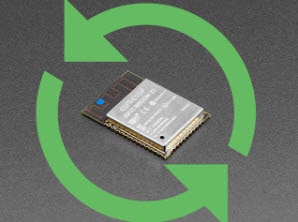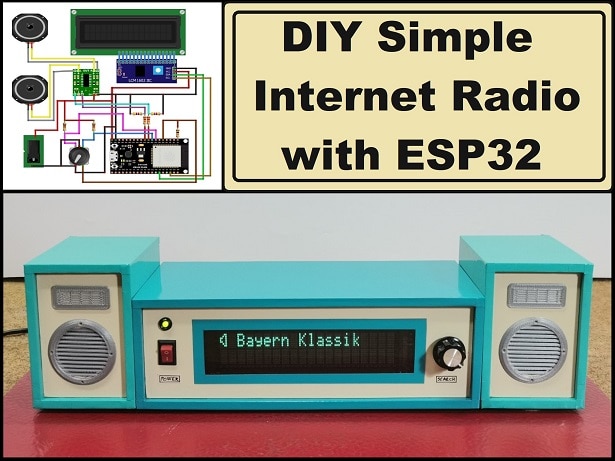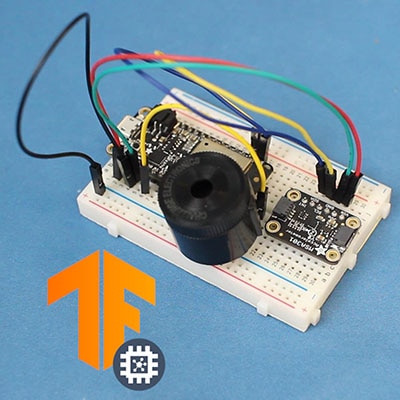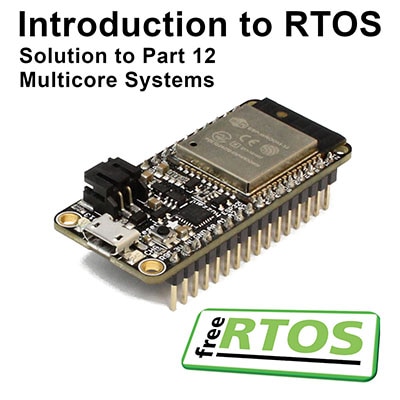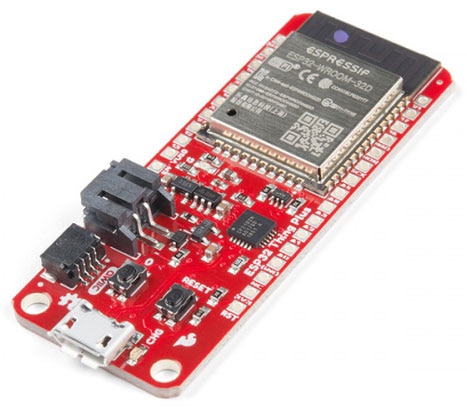A Guide for the ESP32 Microcontroller Series
2024-05-29 | By Don Wilcher
The ESP32 microcontrollers have spawned into a central part of the Internet of Things (IoT) and embedded controller arena. Espressif Systems, the manufacturer of the ESP32 ecosystem, has created powerful and affordable System-on-Chip (SoC) devices that integrate Wi-Fi, Bluetooth, and central processing units (CPUs) into one microcontroller package, allowing these SoCs to be ideal for embedded controllers and IoT projects.
Navigating the terrain of the various ESP32 hardware platforms and software packages can be a daunting task for the engineer or maker. This guide will provide information on technical specifications, development kits, and software design kits (SDKs) related to the ESP32 microcontroller ecosystem. With such a guide, you will be able to select the appropriate ESP32 microcontroller device for your specific project requirements.
 Typical ESP32 microcontroller. Image courtesy of Wikipedia
Typical ESP32 microcontroller. Image courtesy of Wikipedia
ESP32 Overview
With low manufacturing development costs and a highly effective processor, you can deploy the ESP32 to various IoT and controller projects. Some key features of the ESP32 microcontroller include Wi-Fi, Bluetooth, and a small form factor. In general, here is a brief overview of the ESP32 microcontroller.
Robust Design
The ESP32 microcontroller is equipped with the ability to remove external circuit interfaces dynamically. This feature ensures its reliable operation even in industrial settings. The operating temperature range of the ESP32 is -40°C to +125°C. The microcontroller can be powered by a supply voltage of +3.3V, which makes it possible to develop wireless remote sensing and controller applications.
Ultra-Low Power Consumption
The ESP32 was designed for portable devices, wearable electronics, smart controllers, and IoT applications. Using a variety of proprietary software packages, ultra-low-power consumption is achieved by the ESP32 microcontroller. Additionally, the ESP32 chip has various power modes, dynamic power scaling, and clock-gating features.
High Level of Integration
A high level of SoC integration allows various electronic circuits to be included with the ESP32. The SoC high-level integration includes the following onboard electronic circuits.
- Built-in antenna switches
- RF balun
- Power amplifier
- Low noise receiver amplifier
- Filters, and
- Power management modules
With such features, functionality, and versatility, the ESP32 microcontroller ecosystem can provide minimal printed circuit board (PCB) space requirements to embedded applications.
 The ESP32 Functional Block Diagram. Image courtesy of Brian Krent (talk · contribs), CC0, via Wikimedia Commons
The ESP32 Functional Block Diagram. Image courtesy of Brian Krent (talk · contribs), CC0, via Wikimedia Commons
Hybrid Wi-Fi, Bluetooth, and Hardwired Communication Interfaces
You can set up a wireless system or device that can be controlled by a host controller using Wi-Fi and Bluetooth. This can help reduce the complexity of the communication system and overhead on the main controller CPU.
The ESP32 microcontrollers come with different communication interfaces like SPI, SDIO, and I2C/UART. These specialized hardwired interfaces provide other communication schemes for a host controller to control device system architecture.
The ESP32 Architecture
The ESP32 Architecture is based on the Xtensa LXn CPU cores. The Xtensa CPU cores use a modular, flexible 32-bit Reduced Instruction Set Computer (RISC) architecture. A RISC device is a microprocessor architecture that uses a small effective set of programming instructions. The small set of programming instructions aids RISC architectures Xtensa processor to scale from a small cache-less controller to a high-performance digital signal processor (DSP).
 A typical RISC Architecture. Image courtesy of javatpoint.
A typical RISC Architecture. Image courtesy of javatpoint.
The Xtensa LXn CPUs
As presented earlier, the Xtensa LXn has various CPU processing capabilities. Here is a list of some of the Xtensa LXn CPUs available for ESP32 microcontrollers:
- LX6 – The Xtensa LX6 CPU is used in the original ESP32 and varieties of the ESP32-S microcontroller family. The Xtensa LX6 is a 32-bit low-power microprocessor having dual-core and single-core configurations. The Xtensa LX6 CPU provides performance and energy efficiency for the ESP32 and ESP32-S microcontroller variants.
- LX7 – The LX7 processor is an enhanced version of the Xtensa LX6 CPU. An efficient 32-bit processor architecture powers the LX7 device. Configurable RISC, data caches, and local memories are integrated into the LX7’s silicon. The ESP32-S2 and the ESP32-S3 microcontrollers use the LX7 features, which are enhancements to the LX6 architecture.
 The LX7 processor architecture. Image courtesy of Cadence.
The LX7 processor architecture. Image courtesy of Cadence.
- RISC-V Cores – The ESP32-C3 and the ESP32-C6 microcontrollers use single-core 32-bit RISC-V processors. The royalty-free, open-source instruction set architecture (ISA) removes expense costs in ESP32-C3 and ESP-C6 chip manufacturing. The RISC architecture uses 5 core blocks: a hardwired control unit (HCU), instruction cache, data cache, data path, and memory. These 5 core blocks use registers, thus allowing reasonable operating speeds for the specified microcontrollers.
ESP32 Subfamilies
If you're working on an IoT, wearable, or embedded controller project, there are plenty of ESP32 microcontrollers to choose from. Below, you'll find a list of different ESP32 microcontroller subfamilies, along with their features and some examples of projects you can create with them.
ESP32 (Original Variant)
- Core Architecture: Xtensa LX6 (single-core or dual-core)
- Technical Specifications:
- Clock Speed: Range (e.g., 80 MHz - 240 MHz).
- Memory: RAM & ROM capacity range (e.g., Up to 520 KiB RAM, 4 MB Flash).
- Has 34 programmable GPIOs, SPI, I2C, I2S, UART, ADC, Motor PWM, LED PWM
a. Wireless Connectivity: Wi-Fi and BLE
b. Power Management: Low-power operation with various sleep modes
c. Security Features: Hardware-based security (e.g., secure boot, encryption)
d. Project Example: Smart home weather station (utilizing dual core for efficient processing).
 ESP32 DevKitM-1
ESP32 DevKitM-1
ESP32-S Series (Successors)
- Core Architecture: Xtensa LX7 (dual-core) - Improved performance and security.
- Variants:
- ESP32-S2: Wi-Fi only (no Bluetooth)
- ESP32-S3: Wi-Fi and BLE
a. Technical Specifications (General - May vary slightly between S2 & S3)
i. Improved clock speeds compared to the original ESP32.
b. USB Support.
c. Memory: 320KB SRAM, 128K ROM
d. Has 43 programmable GPIOs, SPI, I2C, I2S, UART, ADC, LED PWM
Project Examples:
- ESP32-S2: Wi-Fi smart plug (single LX7 core sufficient).
- ESP32-S3: Wearable fitness tracker (dual LX7 cores for real-time processing).
 ESP32-S3 DevKitM-1
ESP32-S3 DevKitM-1
ESP32-C Series (RISC-V Cores)
- Core Architecture: Single-core 32-bit RISC-V (potentially lower cost)
- Variants:
- ESP32-C3: Wi-Fi and BLE
- ESP32-C6 (Upcoming): Details not fully confirmed yet.
-
a. Technical Specifications (General - May vary between C3 & C6)
- Clock Speed: Likely similar range to other ESP32s (80 MHz - 240 MHz - Confirmation needed for C6).
- Memory: Likely similar to or increased capacity compared to ESP32-C3 (e.g., ESP32-C3: Up to 4MB Flash, 400 KiB RAM)
- Has 14 programmable GPIOs, SPI, I2C, UART, LED PWM, ADC,
- Wireless Connectivity (C3): Wi-Fi and BLE (Confirmation needed for C6)
Project Example (ESP32-C3): Wireless soil moisture sensor (cost-sensitive application).
 ESP32-C6 DevKitM-1
ESP32-C6 DevKitM-1
ESP32-H2(integrates the IEEE 802.15.4 connectivity with Bluetooth 5 Low Energy (LE).
- Core Architecture: Single-core, 32-bit RISC-V microcontroller.
- Variants: No variants as of today
- Technical Specifications (General)
- Clock Speed -96 MHz
- Memory: 320 KB of SRAM with 16KB of Cache, 128KB of ROM, and Flash Memory of 4MB
- Has 19 programmable GPIOs with support for ADC
- SPI, UART, I2C, I2S, GDMA, and LED PWM
- Wireless Connectivity: IEEE 802.15.4 (Mesh Network) and Bluetooth 5 (LE)
Project Example (ESP32-H): Smart Agriculture System (can monitor environmental conditions like soil, temperature, and light levels application).
 ESP32-H2 DevKitM-1
ESP32-H2 DevKitM-1
ESP32-P4 (powered by a dual-core RISCV CPU)
- Has AI Instruction Extensions.
- Advanced Memory Subsystem and integrated high-speed peripherals
- Positioned for the forthcoming era of embedded applications
- Specific Application areas:
- Human Machine Interfaces (HMI)
- Edge Computing
- Increased IO-connectivity demands
- ESP32-P4 development kits coming soon
ESP32 Software Development Kits (SDKs)
With various ESP32 development kits, Espressif has provided a resource of programming tools. The SDKs are available for the ESP32 microcontrollers presented in this guide by downloading from open-source GitHub repositories. Documentation is available with sample code to ensure the main features of each ESP32 microcontroller can be easily explored. The following is a short list of available SDKs for the ESP32 microcontroller ecosystem.
- ESP-IDF – The official IoT Development Framework for the ESP32, ESP32-S, ESP32-C, and ESP32-H family of SoCs. The SDK allows typical or generic applications to be built on these microcontroller platforms. Traditional programming languages like C and C++ are used to develop microcontroller applications using the SDK.
- ESP-Matter – This software implementation of the Matter protocol is a collaborative effort of the Computer Software Assurance (CSA) and company members. This consortium of company members and the CSA allows device implementation on Android and iOS controllers. The ESP microcontrollers play an integral role in the open-source Matter SDK development.
- Arduino-ESP SDK – This SDK, also known as the Arduino core, is a software development kit for the ESP32 that allows developers to program this microcontroller ecosystem. The core is included with the Arduino integrated development environment (IDE). Lastly, the Arduino IDE is a collection of software libraries, and example code for the ESP32 development kits and boards.
Conclusion
The ESP32 microcontrollers offer versatility and powerful solutions for industrial and commercial IoT applications. The ESP32 ecosystem is integrating powerful processing capabilities, reliable connectivity, and advanced security features. Whether deployed in energy-efficient sensors or rugged industrial monitoring systems, the ESP32 microcontrollers provide the flexibility and performance needed to drive innovation and address the diverse challenges of the IoT landscape. This guide provides an overview of the ESP32 microcontroller, including its programmable platform, capabilities, and features to assist you in selecting the appropriate device for your innovative projects.









